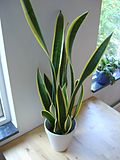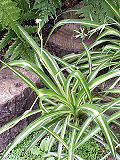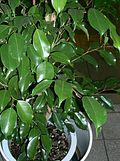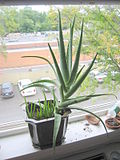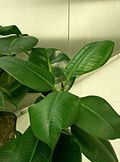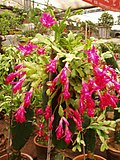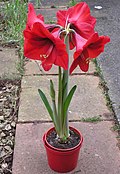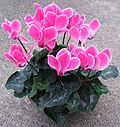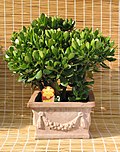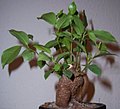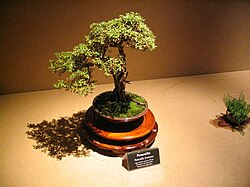Difference between revisions of "AY Honors/House Plants/Answer Key/es"
(Created page with "<noinclude>") |
(Created page with "<noinclude>") |
||
| Line 76: | Line 76: | ||
{{ansreq|page={{#titleparts:{{PAGENAME}}|2|1}}|num=4}} | {{ansreq|page={{#titleparts:{{PAGENAME}}|2|1}}|num=4}} | ||
<noinclude></noinclude> | <noinclude></noinclude> | ||
| − | <!-- 4. A la mayoría de plantas caseras les gusta la temperatura entre | + | <!-- 4. A la mayoría de plantas caseras les gusta la temperatura entre 65 a 75° F (18 a 22° C ). Nombrar una que requiere una habitación fresca de 45 a 55° F (7 a 13° C). --> |
El '''ciclamen''' (también conocido como artánita o pan de puerco) comúnmente vendido por los floristas es ''C. persicum'', que se congela fácil. Los cultivares seleccionados del ciclamen pueden tener flores blancas, rosadas brillantes, rojas o púrpuras. Mientras que florecen, los ciclámenes de los floristas se deben mantener debajo de 20° C (68° F), con las temperaturas de la noche preferiblemente entre 6,67 °C a 15 °C (44 °F a 59 °F). Las temperaturas más de 20 °C (68 °F) pueden hacer que la planta permanezca inactiva. | El '''ciclamen''' (también conocido como artánita o pan de puerco) comúnmente vendido por los floristas es ''C. persicum'', que se congela fácil. Los cultivares seleccionados del ciclamen pueden tener flores blancas, rosadas brillantes, rojas o púrpuras. Mientras que florecen, los ciclámenes de los floristas se deben mantener debajo de 20° C (68° F), con las temperaturas de la noche preferiblemente entre 6,67 °C a 15 °C (44 °F a 59 °F). Las temperaturas más de 20 °C (68 °F) pueden hacer que la planta permanezca inactiva. | ||
| Line 109: | Line 109: | ||
{{CloseReq}} <!-- 7 --> | {{CloseReq}} <!-- 7 --> | ||
{{ansreq|page={{#titleparts:{{PAGENAME}}|2|1}}|num=8}} | {{ansreq|page={{#titleparts:{{PAGENAME}}|2|1}}|num=8}} | ||
| − | <noinclude> | + | <noinclude></noinclude> |
| − | </noinclude> | + | <!-- 8. Nombrar dos plantas de casa que pueden propagarse a partir de las hojas, secciones o divisiones del tallo. Cultivar una planta de dos de estos métodos y cultivarla durante al menos seis meses. --> |
| − | <!-- 8. | ||
| − | |||
| − | + | {{clear}} | |
| − | |||
| − | |||
| − | |||
| − | + | {{clear}} | |
| − | |||
| − | |||
| − | + | {{clear}} | |
| − | |||
| − | |||
| − | |||
| − | |||
| − | + | La estratificación natural ocurre típicamente cuando una rama toca el suelo, después de lo cual produce raíces adventicias. En una etapa más tarde la conexión con la planta madre se corta y se produce una nueva planta como resultado. | |
| − | |||
| − | |||
| − | + | {{clear}} | |
| − | |||
| − | |||
| − | + | {{clear}} | |
| − | |||
| − | |||
| − | |||
| − | |||
| − | + | {{clear}} | |
| − | |||
| − | |||
| − | + | {{clear}} | |
| − | |||
| − | |||
| − | + | {{clear}} | |
| − | |||
| − | |||
| − | |||
| − | |||
| − | + | {{clear}} | |
| − | |||
| − | |||
| − | + | <noinclude></noinclude> | |
| − | |||
| − | <noinclude | ||
| − | |||
{{ansreq|page={{#titleparts:{{PAGENAME}}|2|1}}|num=8a}} | {{ansreq|page={{#titleparts:{{PAGENAME}}|2|1}}|num=8a}} | ||
| − | <noinclude> | + | <noinclude></noinclude> |
| − | </noinclude> | + | <noinclude></noinclude> |
| − | <noinclude | ||
| − | |||
{{CloseReq}} <!-- 8a --> | {{CloseReq}} <!-- 8a --> | ||
{{ansreq|page={{#titleparts:{{PAGENAME}}|2|1}}|num=8b}} | {{ansreq|page={{#titleparts:{{PAGENAME}}|2|1}}|num=8b}} | ||
| − | <noinclude> | + | <noinclude></noinclude> |
| − | </noinclude> | + | <noinclude></noinclude> |
| − | <noinclude | ||
| − | |||
{{CloseReq}} <!-- 8b --> | {{CloseReq}} <!-- 8b --> | ||
{{ansreq|page={{#titleparts:{{PAGENAME}}|2|1}}|num=8c}} | {{ansreq|page={{#titleparts:{{PAGENAME}}|2|1}}|num=8c}} | ||
| − | <noinclude> | + | <noinclude></noinclude> |
| − | </noinclude> | + | <noinclude></noinclude> |
| − | <noinclude | ||
| − | |||
{{CloseReq}} <!-- 8c --> | {{CloseReq}} <!-- 8c --> | ||
{{ansreq|page={{#titleparts:{{PAGENAME}}|2|1}}|num=8d}} | {{ansreq|page={{#titleparts:{{PAGENAME}}|2|1}}|num=8d}} | ||
Revision as of 13:54, 14 April 2021
Nivel de destreza
2
Año
1976
Version
19.12.2025
Autoridad de aprobación
Asociación General
1
2
3
3a
Plantas caseras adaptadas a la luz directa del sol
3b
3c
Plantas caseras adaptadas a suelos muy húmedos
4
El ciclamen (también conocido como artánita o pan de puerco) comúnmente vendido por los floristas es C. persicum, que se congela fácil. Los cultivares seleccionados del ciclamen pueden tener flores blancas, rosadas brillantes, rojas o púrpuras. Mientras que florecen, los ciclámenes de los floristas se deben mantener debajo de 20° C (68° F), con las temperaturas de la noche preferiblemente entre 6,67 °C a 15 °C (44 °F a 59 °F). Las temperaturas más de 20 °C (68 °F) pueden hacer que la planta permanezca inactiva.
5
6
7
La Saintpaulia, comúnmente conocida como la violeta africana, es un género de seis especies de plantas herbáceas perennes que florecen en la familia Gesneriaceae, oriunda de Tanzanía y al adyacente sureste de Kenia en África oriental tropical, con una concentración de especies en las montañas Nguru de Tanzanía.
Las violetas africanas prefieren una temperatura constante entre 20-25° C (68-77° F) con alta humedad y prosperan mejor sembradas en humus bien drenado o compost de ensalada. A veces pensamos en los trópicos como lugares muy CALIENTES y HUMEDOS, pero bajo los altos árboles de un verdadero ambiente tropical, la temperatura es bastante moderada y cómoda, aunque la cantidad de humedad en el aire es más alta que en muchos lugares en el oeste de los EE. UU.
En términos prácticos de planta casera, esto significa que las violetas africanas y otros gesnariados se sienten cómodos en las mismas temperaturas y niveles de humedad que los seres humanos, A MENOS que la violeta africana se coloque cerca de un aire acondicionado, donde el aire frío y seco hará que se pierda.
8
La estratificación natural ocurre típicamente cuando una rama toca el suelo, después de lo cual produce raíces adventicias. En una etapa más tarde la conexión con la planta madre se corta y se produce una nueva planta como resultado.
8a
8b
8c
8d
8e
8f
8g
8h
8i
8j
8k
8l
8m
8n
8o
8p
8q
8r
8s
8t
8u
9
Bonsai is the art of aesthetic miniaturization of trees by growing them in containers. Cultivation includes techniques for shaping, watering, and repotting in various styles of containers. The word bonsai has been used in the West as an umbrella term for all miniature trees.
10
Humidity is the amount of water vapor in the air. The term "humidity" is usually taken in daily language to refer to relative humidity. Relative humidity is defined as the amount of water vapor in a sample of air compared to the maximum amount of water vapor the air can hold at any specific temperature in a form of 0 to 100%.
Humidity, along with temperature, moisture, light, soil mixture, fertilizers, potting, and pest control, is one of the critical factors that should be considered when caring for a houseplant.
Humidity is slightly more difficult to control than temperature. The more commonly used houseplants have established that they can survive in low humidity environments as long as their roots are kept properly irrigated. Most plants thrive in 80% relative humidity while most homes are usually kept around 20% to 60% relative humidity. Besides buying a humidifier, there are a few things that can be done to increase humidity around houseplants. The most popular methods used to raise the ambient humidity are misting and pebble trays, which are shallow trays covered with pebbles and filled with water that evaporates to increase humidity. Other methods of raising humidity include grouping plants closely together and not placing plants in drafty areas. Misting is somewhat controversial among gardeners, with some that swear by it and others that say it does little to increase humidity around plants.
11
a. Violeta africana
b. Aspidistra
c. Planta de aluminio
d. Narciso amarillo
e. Gloxinia
f. Culantrillo
g. Tolmiea
h. Tulipán
i. Helecho común
j. Begonia
k. Asplenio
l. Ficus
m. Jacinto
n. Narciso
o. Lazo de amor (cinta, malamadre, araña)
p. Cóleo
q. Crocus (azafrán)
r. Caladium (oreja de elefante)
s. Geranio
t. Iris
u. Filodendro
v. Sansevieria


